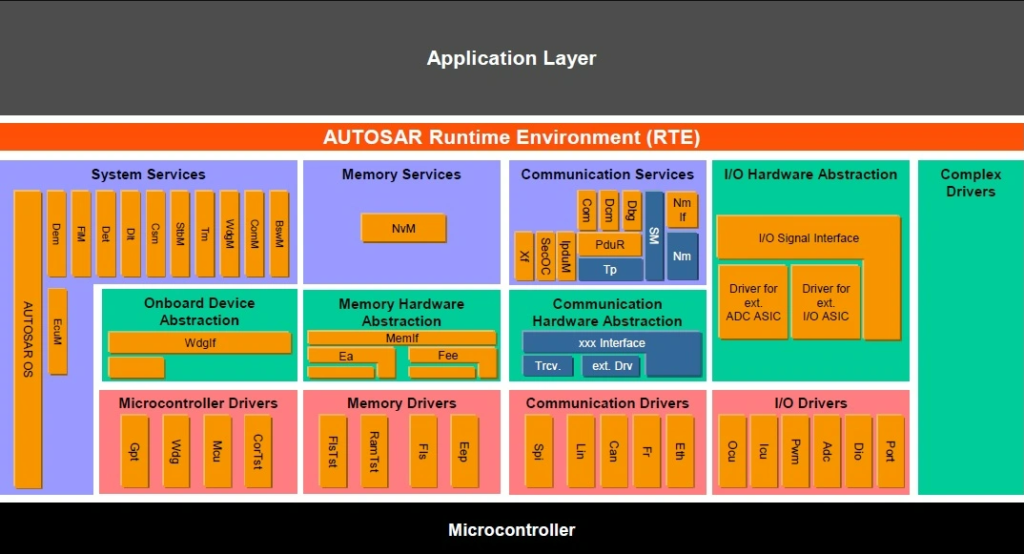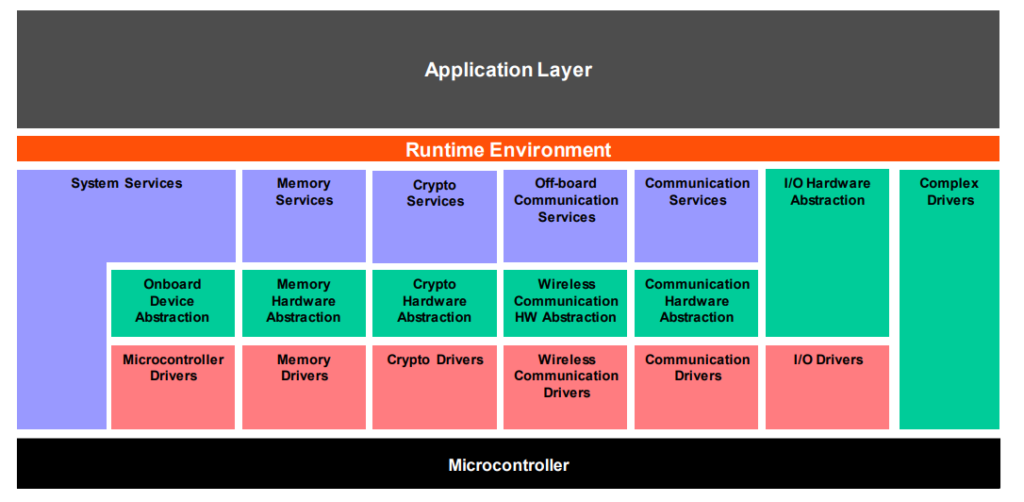Title: Understanding the COM Stack in AUTOSAR: A Comprehensive Guide
Introduction:
In the realm of automotive software development, AUTOSAR (Automotive Open System Architecture) has become a cornerstone framework for creating standardized, modular, and scalable software solutions. At the heart of AUTOSAR lies the Communication Stack, commonly referred to as the COM stack, which plays a vital role in enabling communication between different software components within an automotive system. In this blog, we will delve into the intricacies of the COM stack, exploring its architecture, components, functionalities, and significance in modern automotive software engineering.
What is the COM Stack?
The Communication Stack (COM stack) in AUTOSAR is a collection of software modules responsible for facilitating communication between various ECUs (Electronic Control Units) in a vehicle. It serves as a middleware layer, abstracting the underlying communication hardware and providing a standardized interface for application software to exchange data seamlessly across the entire automotive network.

Architecture of the COM Stack:
The COM stack architecture in AUTOSAR typically comprises several layers, each fulfilling specific communication-related tasks:
- Communication Interface (ComIF):
- At the lowest level, the Communication Interface acts as an abstraction layer between the COM stack and the underlying communication hardware (e.g., CAN, LIN, Ethernet).
- It provides standardized APIs (Application Programming Interfaces) for transmitting and receiving data over different communication buses.
- The ComIF layer ensures hardware independence, allowing the upper layers of the COM stack to remain agnostic to the underlying communication protocols.
- Basic Software (BSW) Modules:
- Sitting atop the ComIF layer are various Basic Software modules responsible for handling different aspects of communication, such as message routing, buffering, and error handling.
- These modules include the PDU Router, I-PDU (Inter-PDU) Multiplexer, and I-PDU Gateway, among others, which collectively manage the transmission and reception of data packets within the COM stack.
- RTE (Run-Time Environment):
- The RTE serves as the interface between the COM stack and the application software running on different ECUs.
- It facilitates the exchange of data between software components by mapping signals and data elements defined in the AUTOSAR software architecture to the corresponding communication PDUs (Protocol Data Units).
- Service Layer:
- The Service Layer encompasses higher-level communication protocols and services, such as diagnostics (UDS – Unified Diagnostic Services), network management (NM), and diagnostics over IP (DoIP).
- These services enable advanced functionalities like diagnostic trouble code (DTC) retrieval, ECU firmware updates, and network configuration management.
Key Components and Functionalities:
Now, let’s explore some of the key components and functionalities within the COM stack:
- Protocol Layers:
- Depending on the communication protocol used in the vehicle network (e.g., CAN, LIN, FlexRay, Ethernet), the COM stack may include protocol-specific layers responsible for encapsulating data into protocol-compliant messages.
- These layers handle tasks such as message framing, error checking, and protocol-specific timing requirements.
- Communication Management:
- The COM stack manages the lifecycle of communication channels, including channel initialization, configuration, and shutdown.
- It also handles communication events such as message transmission confirmations, reception notifications, and error detection.
- Data Serialization and Deserialization:
- To ensure interoperability between different ECUs, the COM stack handles the serialization (packing) and deserialization (unpacking) of application data into/from communication PDUs.
- This process involves converting application-level data structures into byte streams compatible with the underlying communication protocol.
- Diagnostic Services:
- In addition to data exchange, the COM stack supports diagnostic services for vehicle diagnostics and maintenance.
- These services enable features like reading sensor values, executing diagnostic routines, and clearing fault codes, enhancing the vehicle’s diagnostic capabilities.
Significance of the COM Stack in AUTOSAR:
The COM stack plays a pivotal role in enabling efficient and reliable communication between diverse software components in modern automotive systems. Its significance can be summarized as follows:
- Standardization:
- By providing a standardized communication interface, the COM stack promotes interoperability and reusability of software components across different vehicle platforms and suppliers.
- It facilitates seamless integration of third-party modules and accelerates the development of complex automotive systems.
- Scalability:
- The modular architecture of the COM stack allows automotive manufacturers to scale their software solutions according to the evolving requirements of vehicle functionalities and communication networks.
- New features and protocols can be seamlessly integrated into the COM stack without major modifications to the existing software architecture.
- Reliability and Safety:
- The COM stack incorporates robust error handling mechanisms and diagnostic services to ensure the reliability and safety of communication within the vehicle network.
- It complies with automotive safety standards (e.g., ISO 26262) by implementing fault-tolerant communication protocols and supporting diagnostic functionalities for identifying and mitigating system failures.
Let’s expand further on a few additional aspects of the COM stack:
Advanced Communication Protocols:
While traditional communication protocols like CAN (Controller Area Network) and LIN (Local Interconnect Network) have been the backbone of automotive networks for decades, the advent of modern vehicles has necessitated support for more advanced protocols. The COM stack in AUTOSAR accommodates a wide range of communication protocols, including FlexRay, Ethernet, and MOST (Media Oriented Systems Transport), to meet the increasing demands for higher bandwidth, lower latency, and deterministic communication. These protocols enable the integration of advanced driver-assistance systems (ADAS), in-vehicle infotainment (IVI), and telematics services, enhancing the overall driving experience and safety.
Security and Cybersecurity:
In an era of connected vehicles and digital ecosystems, ensuring the security and cybersecurity of automotive communication systems is paramount. The COM stack addresses these concerns by implementing robust security mechanisms and protocols to safeguard against unauthorized access, data tampering, and cyber threats. Secure communication protocols such as TLS (Transport Layer Security) and IPsec (Internet Protocol Security) are supported, enabling encrypted communication channels between ECUs and external entities. Additionally, the COM stack incorporates features for secure bootstrapping, authentication, and access control, mitigating the risks associated with software vulnerabilities and malicious attacks.
Over-the-Air (OTA) Updates:
With the increasing complexity of automotive software and the need for continuous improvement, Over-the-Air (OTA) updates have emerged as a critical capability facilitated by the COM stack. OTA updates allow automotive manufacturers to remotely deploy software patches, firmware upgrades, and configuration changes to vehicles, without requiring physical access to the ECUs. The COM stack supports OTA update protocols such as HTTP (Hypertext Transfer Protocol) and CoAP (Constrained Application Protocol), enabling efficient and secure delivery of software updates over cellular or Wi-Fi networks. By embracing OTA updates, automakers can enhance vehicle functionality, address software bugs, and ensure compliance with regulatory requirements, all while minimizing downtime and inconvenience for vehicle owners.
Real-Time Communication:
In safety-critical automotive applications, such as active safety systems and vehicle control functions, real-time communication is essential to guarantee timely and deterministic message delivery. The COM stack provides mechanisms for real-time communication, including support for time-triggered protocols, message prioritization, and deterministic scheduling. By adhering to strict timing constraints and minimizing communication latencies, the COM stack enables reliable operation of critical safety functions, ensuring that vehicles respond promptly to changing driving conditions and potential hazards.
Interoperability and Ecosystem Integration:
The COM stack fosters interoperability and ecosystem integration by adhering to open standards and industry specifications. It supports interoperability with third-party software components, tools, and middleware solutions, enabling seamless integration into the broader automotive ecosystem. By embracing open standards such as AUTOSAR and adopting modular, vendor-neutral architectures, automotive manufacturers can leverage a diverse ecosystem of software suppliers and technology partners, accelerating innovation and reducing time-to-market for new vehicle features and services.
Conclusion:
In conclusion, the Communication Stack (COM stack) in AUTOSAR serves as a foundational element for establishing efficient, standardized, and reliable communication within automotive systems. By abstracting the complexities of communication hardware and providing a modular framework for software development, the COM stack empowers automotive engineers to build scalable, interoperable, and safety-critical software solutions for next-generation vehicles. As automotive technology continues to evolve, the COM stack will remain a cornerstone of innovation, enabling the realization of advanced driver-assistance systems (ADAS), autonomous driving functionalities, and connected car services.
References:
- AUTOSAR (Automotive Open System Architecture) Specifications.
- ISO 26262: Road vehicles – Functional safety.
- Unified Diagnostic Services (UDS) Specification.
- DoIP (Diagnostics over IP) Specification.

